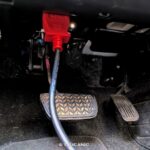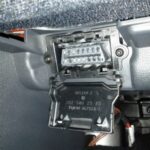Swapping a B18C1 engine, commonly known as the GSR engine, into older Honda vehicles is a popular upgrade for enthusiasts seeking more power. A common point of confusion during this swap revolves around engine wiring harnesses and ECU compatibility – specifically, whether to use OBD1 or OBD2 components. Navigating the choices between OBD1 and OBD2 for your B18C1 swap can seem daunting, but understanding the nuances can save you time, money, and headaches. This guide breaks down the most effective approach, focusing on leveraging an OBD2 USDM Integra engine harness to streamline your B18C1 swap into an OBD1 chassis.
The Smart Way: OBD2 Integra Harness for Your B18C1 Swap
Forget the complexities of splicing wires or the added expense and bulk of conversion adapters. The most efficient method for wiring your B18C1 engine involves utilizing an OBD2 USDM (United States Domestic Market) Integra engine harness. Here’s why this approach stands out:
- Direct Fit Compatibility: OBD2 Integra harnesses (specifically from 1996+ Integras, readily found in junkyards) are designed with a two-piece construction. This crucial design feature means they have separate plugs near the strut towers, mirroring the setup of OBD1 Civic harnesses. This is unlike one-piece OBD2 Civic harnesses, which are less adaptable for this swap.
- Plug-and-Play Simplicity: By using an OBD2 Integra harness, you eliminate the need to modify essential engine components like the alternator, injectors, or distributor. Everything connects seamlessly, saving you considerable time and effort.
- Avoids Common Pitfalls: The outdated methods of swapping to OBD1 parts or attempting to splice OBD2 Civic harnesses are not only complex but also introduce potential points of failure and frustration. The OBD2 Integra harness sidesteps these issues entirely.
![]() OBD2 Integra engine harness plugs into OBD1 Civic chassis at strut towers
OBD2 Integra engine harness plugs into OBD1 Civic chassis at strut towers
The OBD2 USDM Integra harness directly plugs into your existing OBD1 Civic chassis harness at the strut towers. You will notice one leftover plug on the OBD2 harness, which is not needed for this application – simply secure it out of the way with a zip tie.
ECU Options for Your B18C1 OBD1/OBD2 Setup
Once your wiring is sorted with the OBD2 Integra harness, you have several options for your Engine Control Unit (ECU) to manage your B18C1 engine. Here’s a breakdown of popular and effective choices:
Option 1 & 2: OBD1 P72 ECU (Manual or Automatic)
The traditional approach involves using an OBD1 USDM P72 ECU, the stock ECU for the B18C1 engine.
- Option 1: Manual P72 ECU: Ideally, you would source a manual P72 ECU. You’ll need to add pins to your Civic ECU harness for essential B18C1 features like the knock sensor, Intake Air Bypass System (IABs), and VTEC (Variable Valve Timing and Lift Electronic Control). Then, run the corresponding wires to the engine. While historically favored, manual OBD1 P72 ECUs are becoming increasingly rare and expensive.
- Option 2: Automatic P72 ECU Conversion: A more budget-friendly alternative is to acquire an automatic OBD1 P72 ECU and convert it for manual use. This conversion process is relatively straightforward and automatic P72 ECUs are generally more affordable and easier to find.
Both OBD1 P72 options can be further enhanced by chipping and tuning the ECU for optimized performance. However, if you plan on tuning, Option 3 might be a more direct and cost-effective route.
Option 3: Chipped P06 or P28 ECU
This option offers a blend of affordability and tuning flexibility.
- Chipped ECU with B18C1 Tune: Obtain a P06 or P28 ECU (common OBD1 Civic ECUs). Chip it, and flash it with a B18C1 base tune. You’ll also need to modify the ECU circuit board to incorporate IABs and VTEC (P28 already has VTEC capability). Consider professional services for chipping and circuit modifications if you’re not experienced in ECU modifications.
- Dyno Tuning Advantage: The significant benefit of this approach is the ability to dyno tune the chipped ECU. While OBD1 P72 ECUs can also be chipped and tuned, starting with a P06 or P28 and custom tuning often provides the most tailored performance for your specific setup.
Option 4: OBD2 P72 ECU with OBD1 to OBD2 Conversion Harness
For those wanting to utilize an OBD2 P72 ECU (stock GSR ECU for OBD2 vehicles), a conversion harness is necessary.
- OBD2 P72 and Conversion Harness: OBD2 P72 ECUs are typically cheaper and easier to source than OBD1 manual P72s. Pair it with an OBD1 to OBD2 conversion harness from reputable suppliers like Rywire.
- Additional Wiring and Modifications: Using a conversion harness requires bypassing the Crankshaft Speed Fluctuation Sensor (CKF) and adding wiring for the knock sensor. These are generally simple procedures. You will also need to add a secondary O2 sensor bung downstream of your catalytic converter, as OBD2 systems utilize two oxygen sensors.
- Legality: Option 4 is considered a more legitimate and potentially more emissions-compliant option, increasing your chances of passing inspections in regions with strict regulations.
Option 5: JDM OBD2 P72 ECU with JDM OBD2 Conversion Harness
This is often the most budget-friendly and straightforward option for achieving a running B18C1 swap.
- JDM OBD2 P72 and Conversion: Utilize a Japanese Domestic Market (JDM) OBD2 P72 ECU with an OBD1 to JDM OBD2 conversion harness.
- Emissions Considerations: Be aware that using JDM components may not pass emissions testing in all locations, particularly in areas like California with stringent Bureau of Automotive Repair (BAR) requirements. Options 1, 2, and 4 are generally considered more likely to pass BAR, with Option 4 being the most compliant.
Conclusion: Streamlining Your B18C1 OBD1/OBD2 Swap
Choosing the right wiring and ECU setup is crucial for a successful B18C1 engine swap. While multiple paths exist, leveraging an OBD2 USDM Integra harness offers a significantly simpler and more efficient solution for OBD1 chassis swaps. Combined with the ECU option that best suits your budget, tuning goals, and local regulations, you can confidently complete your B18C1 swap and enjoy the enhanced performance of your Honda.

